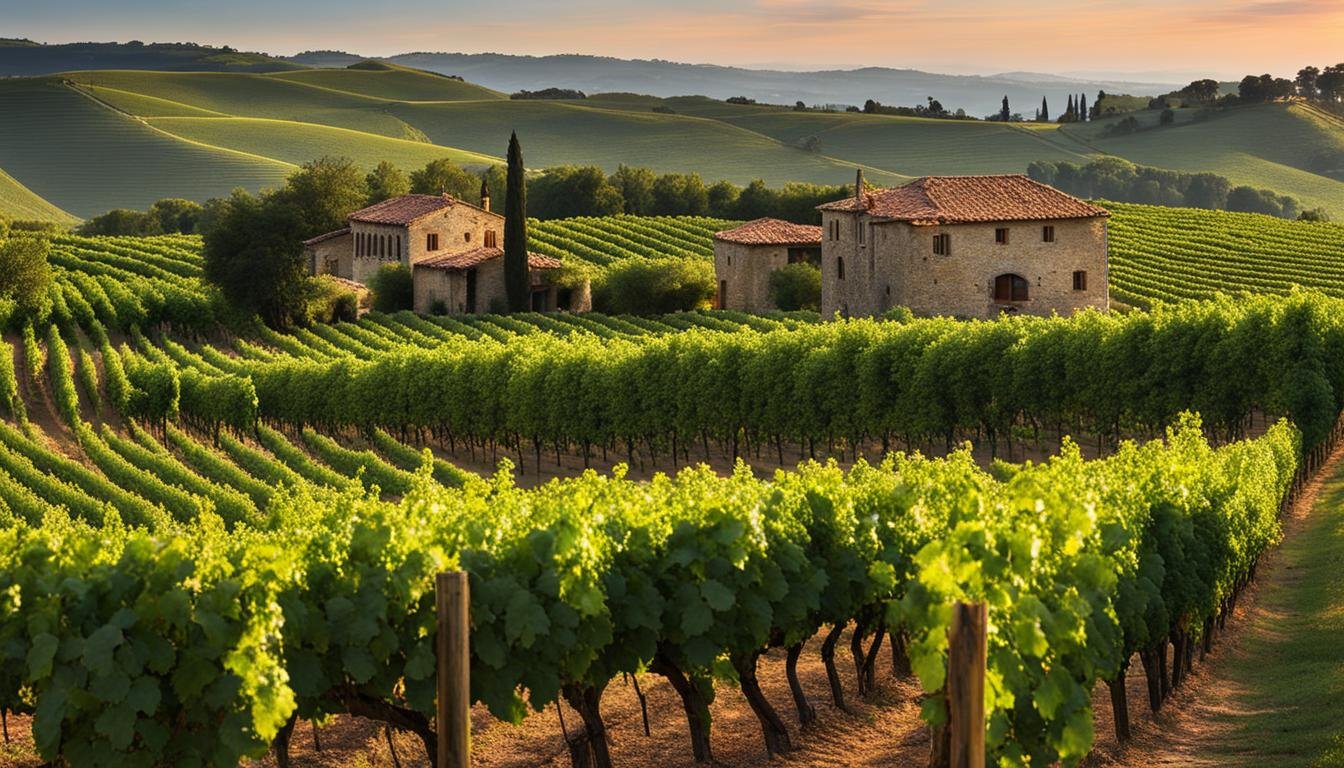This post may contain affiliate links. Please read my disclosure policy.
Aglianico: Italy’s Enigmatic and Ancient Vine
Introduction
Aglianico, pronounced “Ahl-YAH-nee-koh,” is like the grand sage of Italian viticulture, steeped in history and brimming with character. Renowned for its ability to produce robust, age-worthy wines, Aglianico is a grape that tells tales of ancient times and volcanic soils. Let’s venture into the world of Aglianico – a wine that embodies the depth, complexity, and spirit of Southern Italy.
Primary Flavours
A foray into a glass of Aglianico is akin to an odyssey through a landscape rich in flavours and aromas. It greets the senses with bold notes of dark cherry, blackberry, and plum, complemented by undertones of leather, earth, and spice. There’s a dignified rusticity to Aglianico, a reflection of its storied past and terroir.
Taste Profile
| Aglianico | ||
|---|---|---|
| Aspect | Rating out of 5 | Characteristic |
| Sweetness | 🍷 | Predominantly dry, with an echo of ancient vineyards |
| Body | 🍷🍷🍷🍷🍷 | Full-bodied, as profound as a philosopher's musings |
| Tannins | 🍷🍷🍷🍷🍷 | Bold and structured, like the ruins of an old Roman villa |
| Acidity | 🍷🍷🍷🍷 | Notably high, adding a lively contrast to the depth |
| Alcohol by Volume | 🍷🍷🍷🍷 | Typically 13-15%, as warming as a Mediterranean sun |
| Each wine glass icon 🍷 represents one point on a 5-point scale. Aglianico is renowned for its strong tannins, high acidity, and substantial body, often contributing to its aging potential. It typically features flavours of dark fruits, earth, and spice, making it a beloved choice for those who appreciate complex and age-worthy wines. | Each wine glass icon 🍷 represents one point on a 5-point scale. Aglianico is renowned for its strong tannins, high acidity, and substantial body, often contributing to its aging potential. It typically features flavors of dark fruits, earth, and spice, making it a beloved choice for those who appreciate complex and age-worthy wines. | Each wine glass icon 🍷 represents one point on a 5-point scale. Aglianico is renowned for its strong tannins, high acidity, and substantial body, often contributing to its aging potential. It typically features flavors of dark fruits, earth, and spice, making it a beloved choice for those who appreciate complex and age-worthy wines. |
Growing Regions
Aglianico is primarily grown in the Campania and Basilicata regions of Southern Italy, with the volcanic soils of these areas lending a unique minerality to the wine. It’s the star of renowned DOCGs like Taurasi in Campania and Aglianico del Vulture in Basilicata, where it reaches its pinnacle of expression.
Origin
With roots tracing back to ancient Greece, Aglianico is one of Italy’s oldest grape varieties. It has been a cornerstone of southern Italian winemaking for centuries, revered for its ability to produce wines of great depth and complexity. Modern winemaking techniques have further unlocked Aglianico’s potential, showcasing its elegance alongside its inherent power.
Serving Temperature
The serving temperature of Aglianico plays a crucial role in unveiling its rich tapestry of flavours and aromas. Ideally, Aglianico should be served at a temperature of around 18°C (64°F). At this warmth, the wine’s bold and complex character can fully express itself. Serving it too cold might restrain its expressive bouquet and mute the intricate layers of flavour, while too warm a temperature could overemphasize alcohol, overshadowing its nuanced profile.
This ideal serving temperature allows Aglianico to display its perfect balance of robust tannins, vibrant acidity, and rich fruit notes. It’s akin to letting a seasoned actor take centre stage at the perfect moment in a play, where every line and gesture contributes to an enthralling performance. By serving Aglianico at this optimal temperature, you’re allowing the wine to tell its full story – a tale of ancient vines, volcanic soils, and Southern Italian sun, a narrative that unfolds with each savoured sip.
Recommended Glass Type
The choice of glassware is pivotal in enhancing the tasting experience of Aglianico. A large, bowl-shaped red wine glass is most suitable for this majestic varietal. The generous size of the bowl allows ample room for the wine to breathe, which is especially important for such a robust and complex wine. This type of glass also provides enough space for swirling, which liberates Aglianico’s diverse bouquet of dark fruits, spices, and earthy notes.
The design of the glass plays a significant role too. A narrower rim focuses the aromas towards the nose, intensifying the perception of the wine’s fragrance, while a wider bowl allows for better oxygenation, softening the wine’s tannins and revealing its layered complexity. The art of enjoying Aglianico is not just in the taste but also in the bouquet, which precedes each sip. By choosing the right glass, you’re setting the stage for a sensory journey through the rustic landscapes of Southern Italy, enhancing the intimate connection between the wine and its connoisseur.
Decanting Duration
Give it a good 1-2 hours to breathe. Aglianico is like a classic novel; it needs time to open up and reveal its full story.
Wine Ageing: Drink Now or Age?
Aglianico ages gracefully, developing more nuanced and sophisticated flavours over time. It’s like a seasoned actor, only getting better with age.
Suggested Food Pairings
Aglianico is bold enough to handle rich and hearty dishes. It pairs beautifully with roasted meats, game, and robust pasta dishes. For a vegetarian twist, try it with a mushroom risotto, eggplant parmigiana, or a hearty bean stew. Its strong character and tannins make it a perfect match for flavoursome and earthy foods.
Wine Labels
Exploring different expressions of Aglianico through various labels can enhance your appreciation of this varietal. Below is a table showcasing some popular brands, highlighting the diversity of this venerable grape:
| Aglianico | Aglianico | Aglianico |
|---|---|---|
| Country | Wine Label | Varietal Name & Style |
| Italy | Feudi di San Gregorio | Taurasi Aglianico - Dry, Full-bodied |
| Italy | Donato D’Angelo | Aglianico del Vulture - Dry, Robust |
| Italy | Mastroberardino | Radici Taurasi - Dry, Aged |
| Italy | Paternoster | Synthesi Aglianico del Vulture - Dry, Elegant |
| Italy | Terredora di Paolo | Taurasi - Dry, Complex |
| Note: These brands represent a range of styles, from traditional to modern, each showcasing Aglianico’s unique character and the terroir of Southern Italy. |
Conclusion
Aglianico is not just a wine; it’s a journey through Italian history and culture. Each sip is like turning a page in an epic saga, full of drama, depth, and character. It’s the kind of wine that doesn’t just accompany a meal; it enhances and transforms it, leaving an indelible impression long after the last drop.
Is Aglianico a red or white wine?
Aglianico is a red wine grape, renowned for creating robust, structured red wines.
What are some interesting facts about Aglianico?
• Aglianico is an ancient grape variety, often referred to as the “Barolo of the South” in Italy.
• It’s native to the southern regions of Italy, particularly Campania and Basilicata.
• Known for producing full-bodied, tannic wines with high acidity.
• Flavours typically include dark fruits, chocolate, and earthy undertones.
To which wines is Aglianico similar?
Aglianico is similar to Nebbiolo and Sangiovese, known for their high tannins, acidity, and ability to age gracefully. These wines share a complexity and depth of flavour, often improving with time.
Where does the name Aglianico originate from?
The name “Aglianico” is believed to derive from “Hellenic” or “Ellenico,” indicating its Greek origins, as the grape was introduced to Italy by the Greeks.
Read the full article about Aglianico here!
User Review
( votes)Sip smarter, subscribe now!
Subscribe for gourmet tips, event updates, travel ideas, and a free e-book on Food Pairings. Start your journey to culinary and travel excellence!














